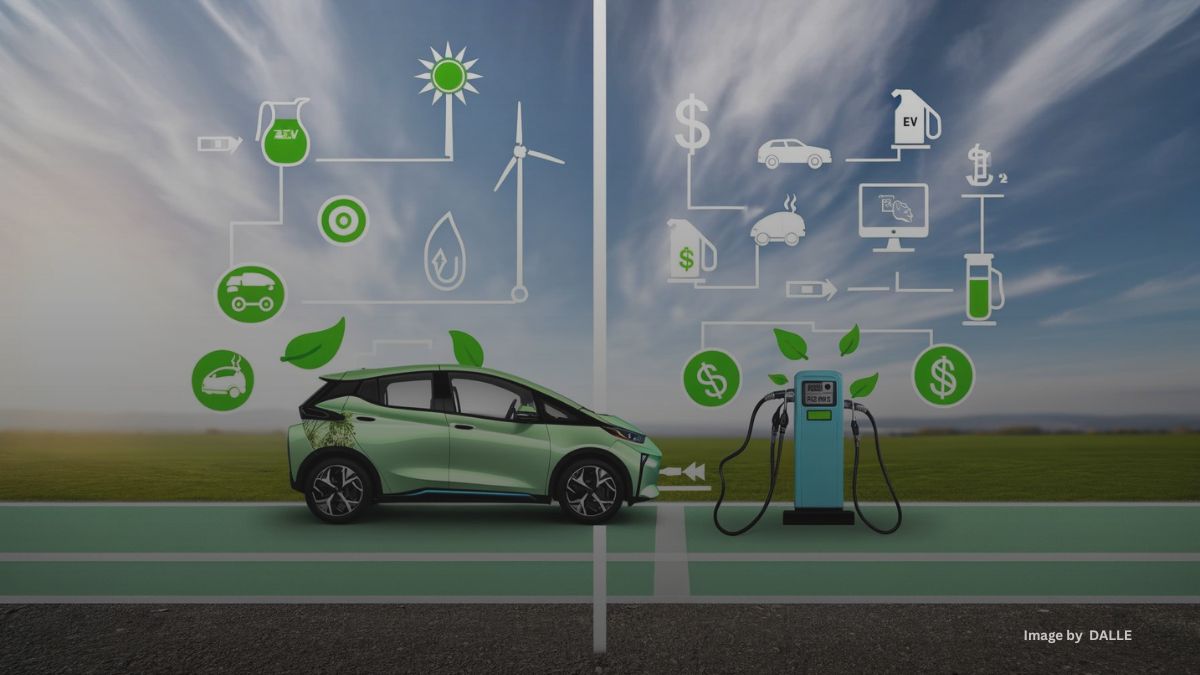Electric vehicles (EVs) are becoming more popular and affordable as technology improves and environmental awareness grows. EVs offer many benefits over gas-powered vehicles, such as lower fuel and maintenance costs, higher energy efficiency, and lower emissions. However, they also have some challenges, such as higher upfront costs, limited driving range, and battery degradation. In this article, we will compare the costs and benefits of electric vehicles with gas-powered vehicles, and see how much you can save and reduce your environmental impact by switching to a zero-emission vehicle (ZEV).
Key Takeaways
- ZEVs are vehicles that produce no tailpipe emissions, such as BEVs and FCEVs.
- ZEVs have lower fuel and maintenance costs, higher energy efficiency, and lower emissions than gas-powered vehicles.
- ZEVs have higher upfront costs, limited driving range, and battery degradation, and a lack of infrastructure compared to gas-powered vehicles.
- To compare ZEVs with gas-powered vehicles, you need to consider several factors, such as the purchase price, the fuel and maintenance costs, the driving range and performance, the emissions and environmental impact, and the availability and convenience of the infrastructure.
- You can use some online tools and calculators to help you make an informed decision based on your specific needs and circumstances.

What is a ZEV?
A ZEV is a vehicle that produces no tailpipe emissions, meaning it does not emit any harmful pollutants or greenhouse gases from the exhaust. There are two main types of ZEVs: battery-electric vehicles (BEVs) and fuel cell electric vehicles (FCEVs). BEVs run solely on electricity stored in a large battery pack that can be recharged from an external source, such as a wall outlet or a public charging station. FCEVs run on hydrogen gas stored in a tank that reacts with oxygen in a fuel cell to produce electricity and water vapor. Both types of ZEVs use electric motors to power the wheels.
IMPORTANT LINKS
- How to Trade in Your Old Gas-Powered Vehicle for an Electric Vehicle with the BC Scrap-It Program
- How to Get a Tax Write-Off for Your Business with the Federal Tax Incentive for Electric Vehicles
- How to Save Money with the Federal iZEV Program for Electric Vehicles
- How to Find the Best Electric Vehicle Charging or Hydrogen Refuelling Station Near You
- How to Buy or Lease a Heavy-Duty Electric Vehicle with the Federal iMHZEV Program
What are the benefits of ZEVs?
ZEVs have many advantages over gas-powered vehicles, both for the individual owner and for the society as a whole. Some of the benefits of ZEVs are:
- Lower fuel costs: Electricity and hydrogen are generally cheaper than gasoline and diesel, especially when considering the higher efficiency of electric motors. According to the U.S. Department of Energy, the average cost of fueling a BEV with electricity is $0.99 per eGallon, compared to $2.85 per gallon of gasoline¹. The cost of hydrogen varies depending on the source and location, but it is estimated to be around $3.00 per kilogram, which is equivalent to $2.70 per gallon of gasoline². However, the fuel economy of FCEVs is typically higher than that of gas-powered vehicles, so the cost per mile may be lower.
- Lower maintenance costs: ZEVs have fewer moving parts than gas-powered vehicles, which means they require less frequent and less expensive maintenance. For example, ZEVs do not need oil changes, spark plugs, or exhaust systems. According to a Consumer Reports study, the average maintenance cost of a BEV over its lifetime is $0.012 per mile, compared to $0.028 per mile for a gas-powered vehicle³.
- Higher energy efficiency: ZEVs convert more of the energy from their fuel source into motion, which means they use less energy to travel the same distance as gas-powered vehicles. According to the U.S. Environmental Protection Agency, the average fuel economy of a BEV is 118 miles per gallon equivalent (MPGe), compared to 27 miles per gallon (MPG) for a gas-powered vehicle⁴. The average fuel economy of an FCEV is 59 MPGe, which is still higher than that of a gas-powered vehicle⁵.
- Lower emissions: ZEVs produce no tailpipe emissions, which means they do not contribute to air pollution or climate change from the vehicle itself. However, the emissions associated with the production and distribution of electricity and hydrogen also need to be considered. Depending on the source of electricity or hydrogen, ZEVs may still have some indirect emissions, but they are generally much lower than those of gas-powered vehicles. According to the U.S. Department of Energy, the average well-to-wheels greenhouse gas emissions of a BEV are 101 grams of CO2-equivalent per mile, compared to 381 grams for a gas-powered vehicle⁶. The average well-to-wheels greenhouse gas emissions of an FCEV are 199 grams of CO2-equivalent per mile, which is also lower than that of a gas-powered vehicle⁷.
What are the challenges of ZEVs?
ZEVs also have some drawbacks that may limit their adoption and appeal to some consumers. Some of the challenges of ZEVs are:
- Higher upfront costs: ZEVs tend to be more expensive to buy upfront than gas-powered vehicles, mainly due to the high cost of batteries and fuel cells. For instance, the electric 2023 Volkswagen ID.4 starts at $38,790, while the similarly sized, gas-powered Volkswagen Tiguan starts at $27,785⁸. However, the price gap may narrow in the future as technology improves and economies of scale are achieved. Additionally, there are various incentives and rebates available for ZEV buyers, such as the federal tax credit of up to $7,500 and state and local programs⁹.
- Limited driving range: ZEVs have a limited driving range before they need to be recharged or refuelled, which may not be sufficient for long trips or rural areas. The average driving range of a BEV is 258 miles, while the average driving range of a FCEV is 312 miles[^10^]. In comparison, the average driving range of a gas-powered vehicle is 412 miles¹¹. However, the driving range of ZEVs may increase as battery and fuel cell technology improves and becomes more affordable.
- Battery degradation: ZEVs rely on batteries that degrade over time and lose their capacity to store energy. This means that the driving range and performance of ZEVs may decline over their lifetime, especially if they are exposed to extreme temperatures or frequent fast charging. The rate and extent of battery degradation vary depending on the type, quality, and usage of the battery, but it is estimated that the average battery life of a BEV is 10 to 15 years¹². However, some manufacturers offer warranties or replacement programs for their batteries to mitigate this issue.
- Lack of infrastructure: ZEVs depend on the availability and accessibility of charging or refuelling stations, which are still limited and unevenly distributed in many areas. According to the U.S. Department of Energy, there are more than 45,000 charging locations with more than 115,000 charging outlets in the United States, but they are concentrated in urban and coastal areas¹³. The number of hydrogen stations is even lower, with only 44 stations in the entire country, mostly in California¹⁴. However, the infrastructure for ZEVs is expected to expand and improve in the coming years, as more public and private investments are made to support the transition to a clean transportation system.
How to compare ZEVs with gas-powered vehicles?
To compare the costs and benefits of ZEVs with gas-powered vehicles, you need to consider several factors, such as the purchase price, the fuel and maintenance costs, the driving range and performance, the emissions and environmental impact, and the availability and convenience of the infrastructure. You also need to take into account your personal preferences, driving habits, and lifestyle. There is no one-size-fits-all answer to whether ZEVs are better or worse than gas-powered vehicles, as different types of vehicles may suit different types of drivers and situations. However, you can use some online tools and calculators to help you make an informed decision based on your specific needs and circumstances. For example, you can use the Vehicle Cost Calculator from the U.S. Department of Energy to compare the total cost of ownership and emissions for different makes and models of vehicles, including ZEVs and gas-powered vehicles¹⁵. You can also use the Fuel Economy Trip Calculator from the U.S. Environmental Protection Agency to compare the fuel economy and fuel cost for different vehicles on a specific trip¹⁶.
Conclusion
ZEVs are a promising alternative to gas-powered vehicles, as they offer many benefits for the individual owner and for the society as a whole, such as lower fuel and maintenance costs, higher energy efficiency, and lower emissions. However, ZEVs also face some challenges, such as higher upfront costs, limited driving range, and battery degradation, and lack of infrastructure. To compare the costs and benefits of ZEVs with gas-powered vehicles, you need to consider several factors, such as the purchase price, the fuel and maintenance costs, the driving range and performance, the emissions and environmental impact, and the availability and convenience of the infrastructure. You also need to take into account your personal preferences, driving habits, and lifestyle. You can use some online tools and calculators to help you make an informed decision based on your specific needs and circumstances.
Source: (1) TESTED: The Zev Technologies OZ9 Elite Is the Maserati of EDC Pistols. https://www.athlonoutdoors.com/article/zev-oz9-elite/. (2) Zev Tech OZ9 Review: Take Competition to the Next Level. https://www.guns.com/news/reviews/zev-tech-oz9-review. (3) Is The ZEV OZ9 Handgun Anything More Than A Cheaper Glock?. https://nationalinterest.org/blog/reboot/zev-oz9-handgun-anything-more-cheaper-glock-168803. (4) Zev OZ9 V2 Elite Hyper Comp: The Best Just Got Better!. https://www.guns.com/news/reviews/zev-oz9-v2-elite-hyper-comp. (5) Electric Cars vs. Gas Cars: Everything You Need to Know – Car and Driver. https://www.caranddriver.com/research/a32781943/electric-cars-vs-gas-cars/.














